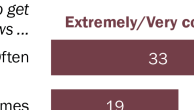Most say they are interested in several types of local crime coverage, but far fewer say it’s easy to find
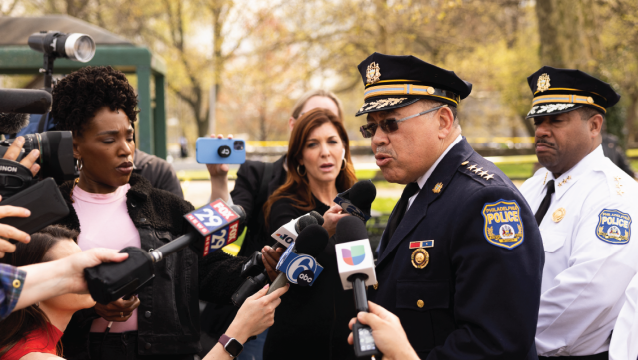
The Pew-Knight Initiative supports new research on how Americans absorb civic information, form beliefs and identities, and engage in their communities.
Pew Research Center is a nonpartisan, nonadvocacy fact tank that informs the public about the issues, attitudes and trends shaping the world. Knight Foundation is a social investor committed to supporting informed and engaged communities. Learn more >
Pew Research Center conducted this study to better understand how U.S. adults get local crime news and information. It is the third report in a series focused on local news.
The survey of 5,146 U.S. adults was conducted from Jan. 22 to 28, 2024. Everyone who completed the survey is a member of the Center’s American Trends Panel (ATP), an online survey panel that is recruited through national, random sampling of residential addresses. This way nearly all U.S. adults have a chance of selection. The survey is weighted to be representative of the U.S. adult population by gender, race, ethnicity, partisan affiliation, education and other categories. Read more about the ATP’s methodology.
Refer to the topline for the questions used for this survey, along with responses, and to the methodology for more details.
This is a Pew Research Center report from the Pew-Knight Initiative, a research program funded jointly by The Pew Charitable Trusts and the John S. and James L. Knight Foundation. Find related reports online at https://www.pewresearch.org/pew-knight/.
This is the third report in a series focused on local news. Read our first report, “Americans’ Changing Relationship With Local News,” and our second report, “How Americans Get Local Political News.”
Crime has long been a major area of focus in local news coverage. In fact, more Americans get news and information about crime than any other local topic except the weather. But how they get that news – and how they react to it – varies widely, according to a new Pew Research Center survey.
Among the key findings:
Around three-quarters of U.S. adults (77%) at least sometimes get news and information about local crime. This includes 34% who do so often.
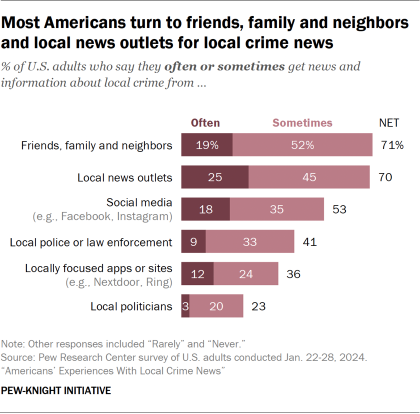
Americans are about as likely to get information about crime from people they know as they are to get it from local news outlets. About seven-in-ten U.S. adults (71%) often or sometimes get news and information about local crime from friends, family and neighbors. A nearly identical share (70%) get this kind of news and information from local news outlets.
Like we find with several local news topics, relatively few Americans are highly satisfied with the local crime news they get. Among those who get local crime news, one-third say they are extremely or very satisfied with the quality of this news. About half (48%) say they are somewhat satisfied, and 18% say they are not too or not at all satisfied.
Many people experience negative emotions after consuming local crime news. Most Americans who get news about local crime say they at least sometimes feel concerned or angry about what is happening after seeing or hearing about it.
Jump to more information on how Americans respond to local crime news.
There is a clear link between the amount of local crime news people take in and their own sense of security. Americans who consume local crime news most often (regardless of the source) also are the most likely to say they are concerned about crime in their community affecting them or their family.

Among U.S. adults who say they often get news about local crime, 33% say they are extremely or very concerned in this way. Smaller shares among those who sometimes (19%) or rarely or never (10%) consume local crime news say they are highly concerned about crime’s impact on them or their family.
This does not necessarily mean that local crime news is always making people worried. It could also be that people who were already concerned about local crime are more likely to follow news about the topic more often.
People’s perceptions of crime also do not always align with actual crime statistics. For instance, Americans tend to believe crime has increased in the United States, even when official data shows it is down.
Perceptions of crime also vary by political party: Republicans are more likely than Democrats to view violent crime as a very big problem in the country as a whole. But there is little difference between the parties’ supporters in how they consume information about local crime and how concerned they are about it.
Democrats (including independents who lean Democratic) are more likely than Republicans and GOP leaners to say various news sources exaggerate the amount of crime in their area and are unfair to some people based on their race or ethnicity. But people aligned with both parties get local crime news at about the same frequency and turn to many of the same types of sources. And virtually identical shares in each party say they are concerned about local crime affecting them or their family.
These findings are based on a recent Pew Research Center survey designed to take a detailed look at Americans’ experiences with and views toward local crime news. This report, the third in a series focused on local news, is part of the Pew-Knight Initiative, a research program funded jointly by The Pew Charitable Trusts and the John S. and James L. Knight Foundation. The first report looked at local news consumption in general, and the second examined news about local government and politics.
The remainder of this overview discusses more key findings from the survey. Four additional sections include greater detail about four aspects of local crime news:
- Sources of crime news
- Types of crime news
- How Americans view the quality of information on the topic
- How Americans respond to the local crime news they consume
What Americans see – and want to see – in local crime news
About a third or more of Americans see news about property crime (37%), drug-related crime (33%) and violent crime (32%) at least weekly. People report seeing news about these different types of crimes at similar rates even though violent crime is far less common than property crime. Fewer people (11%) see news about white-collar crime (e.g., corporate fraud or political corruption) at least weekly.
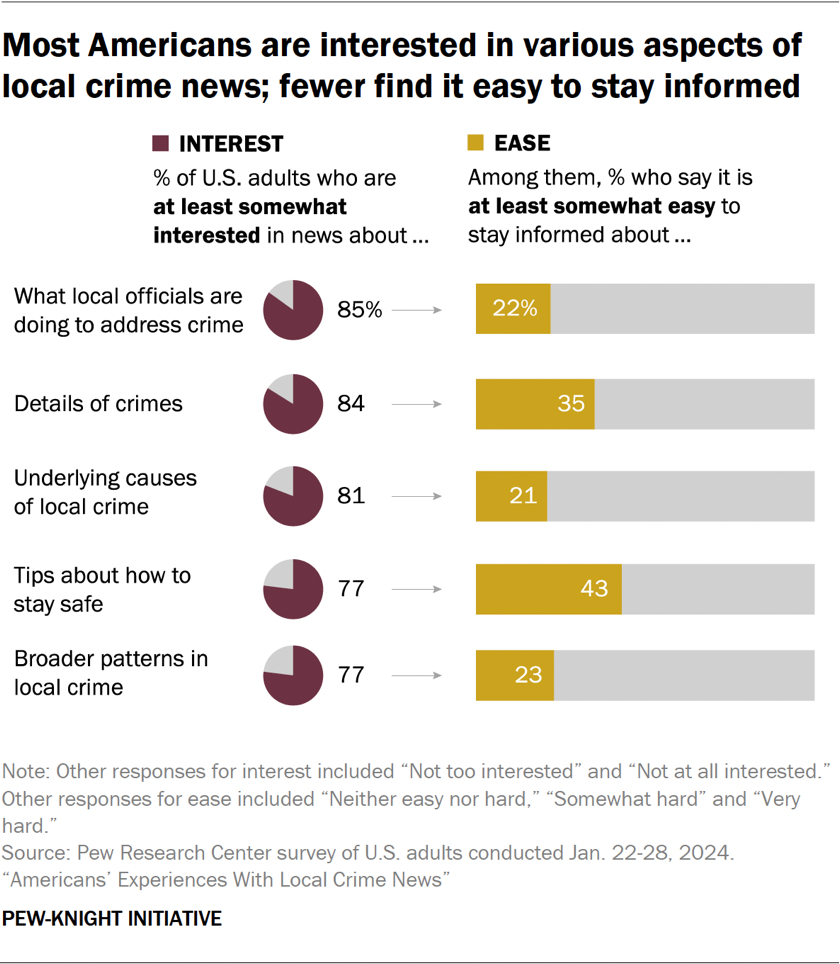
The survey also asked whether Americans are interested in a variety of types of crime news, including details of crimes, tips about how to stay safe, and broader patterns in local crime. About three-quarters or more of U.S. adults say they are at least somewhat interested in each of the five topics we asked about. But relatively few of those who are interested say it is easy to find news and information about each topic.
For instance, most Americans (85%) say they are at least somewhat interested in what local officials are doing to address crime. But among those who are interested in this element of crime coverage, only 22% say it is at least somewhat easy to find this information, while almost twice as many (41%) say it’s very or somewhat hard to find.
Jump to more information on types of local crime news.
Sources of local crime news, and how local TV news consumers stand out
Americans get local crime news from a variety of different sources. The most common are friends, family and neighbors and local news outlets: About seven-in-ten U.S. adults often or sometimes get information about local crime from each source (71% and 70%, respectively).
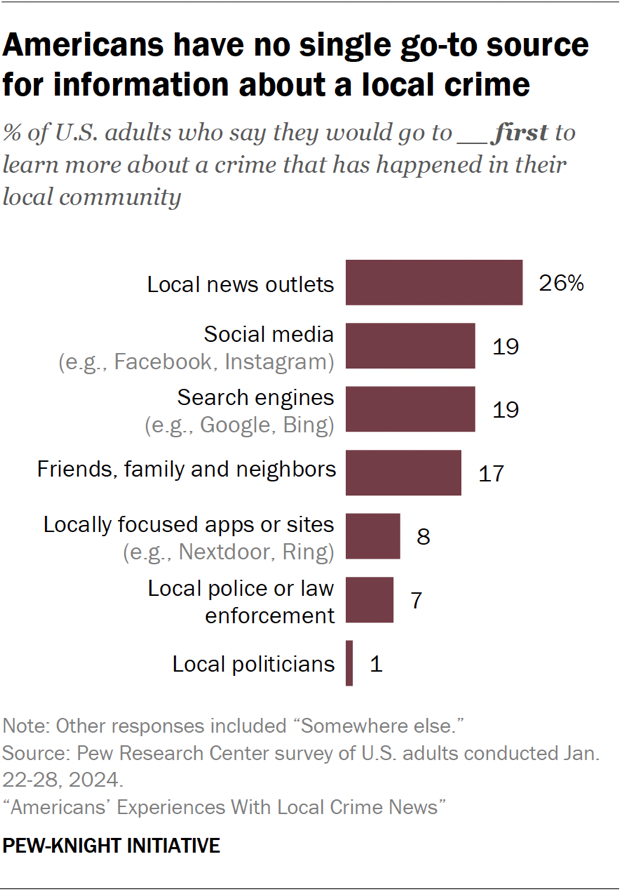
But when asked where they would go first for more information if a crime happened in their community, Americans do not coalesce around a single dominant source.
About a quarter (26%) say they would first go to local news outlets. Slightly smaller shares would go to social media (19%), search engines (19%), or friends, family and neighbors (17%). Others turn to local apps like Nextdoor or Ring (8%) or local police or law enforcement (7%).
Jump to more information on sources of local crime news.
Our survey did not measure what types of local news outlets people turn to for local crime news specifically. But the survey did ask what platform Americans prefer for getting local news and information in general.
Americans who say they prefer to get local news on TV stand out in some ways when it comes to crime news. These local TV news consumers report getting local crime news more often than those who prefer other platforms, but they are generally less likely to say that local news outlets exaggerate the amount of crime in their community. They also are more likely to say they are satisfied with the quality of local crime news they get.
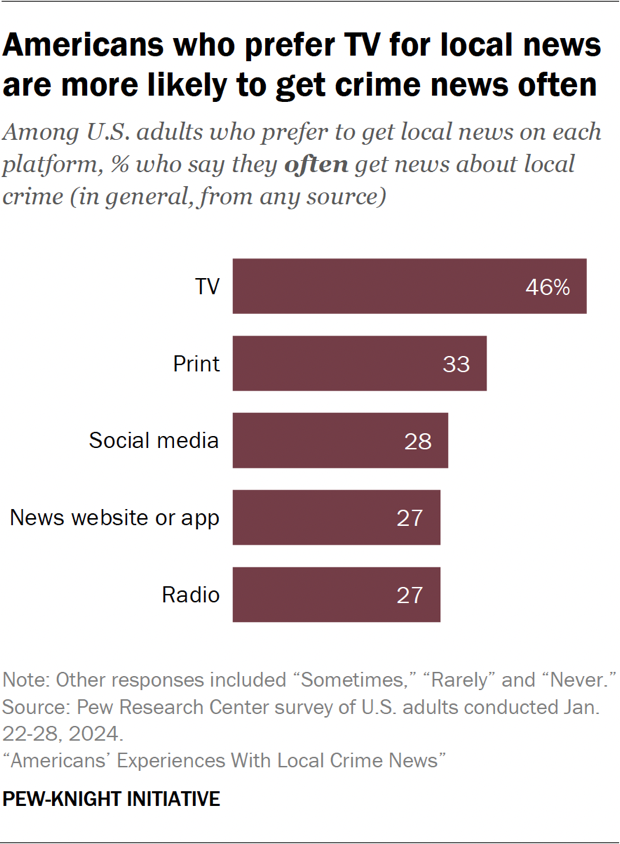
Nearly half of those who prefer TV for local news (46%) say they often get news and information about local crime from any source, higher than those who prefer any other platform. This group also is more likely than those who prefer any other platform to report seeing news about local violent crime about daily.
That said, Americans who prefer TV for local news are not especially likely to say that local news outlets exaggerate the amount of crime in their local community. In fact, just 9% of these adults take this view, while a slightly larger share (16%) say local news outlets underplay the amount of crime in their area and 60% say they get it about right.
Those who prefer social media (22%) or news websites or apps (20%) for local news are more likely to say that local news outlets exaggerate the amount of crime in their community.
Americans’ varying perceptions of local crime news
Among Americans who get news about local crime, just a third are extremely or very satisfied with its quality.
However, views of crime news vary depending on where people are getting it. Americans differentiate between sources of crime news – such as local news outlets, social media, and family, friends and neighbors – when it comes to how accurate, exaggerated or fair they believe the information is:
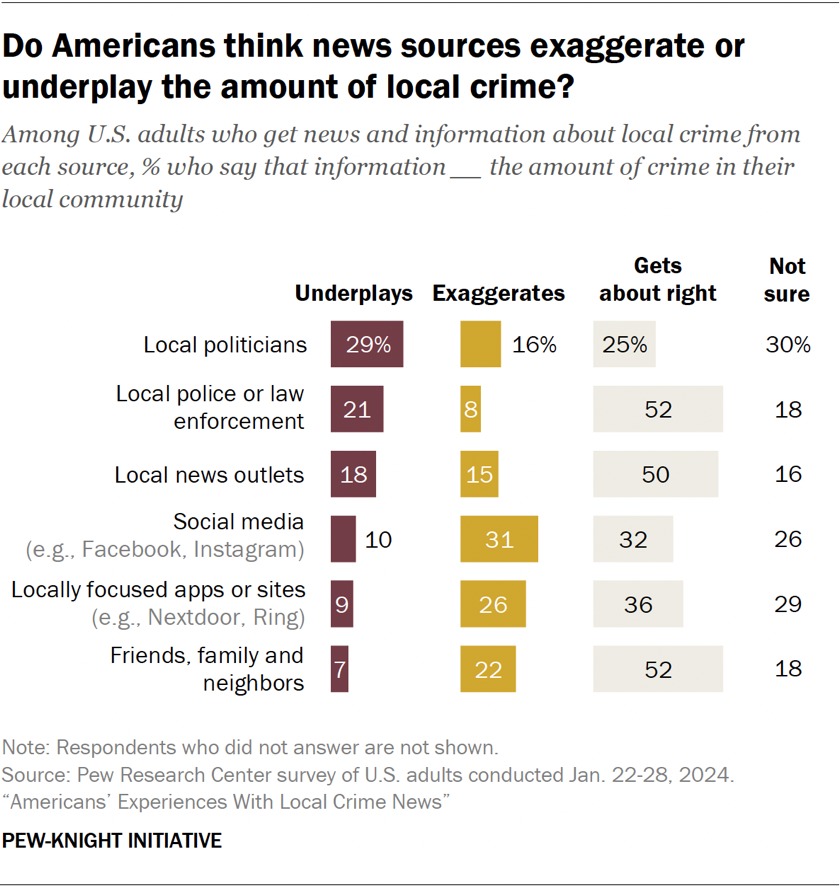
- U.S. adults who get crime news from local news outlets (79%), local law enforcement (77%), and friends, family and neighbors (72%) are more likely than those who get it from other sources to say the information is at least somewhat accurate. The higher level of confidence in information from local law enforcement than local politicians mirrors a broader pattern of higher trust in police officers than elected officials.
- Those who get local crime news from more social sources (social media, locally focused apps, or friends, family and neighbors) are more likely to say such news exaggerates rather than underplays the amount of crime in their community.
- Those who get local crime information from official sources (local law enforcement and local politicians), meanwhile, are more likely to say it underplays rather than exaggerates the amount of crime in their area.
- More than half of U.S. adults who get local crime news from friends, family and neighbors (65%), local news outlets (63%) and local law enforcement (57%) say these sources are generally fair to everyone regardless of their race or ethnicity. Black Americans and Democrats are less likely than others to say this about local police.
- In general, smaller shares of those who get local crime news from locally focused apps (46%), social media (43%) or local politicians (41%) say these sources are fair to people across racial and ethnic groups, although many say they are not sure whether these sources are fair.
Jump to more information on the public’s attitudes toward local crime news.
How different demographic groups experience local crime news
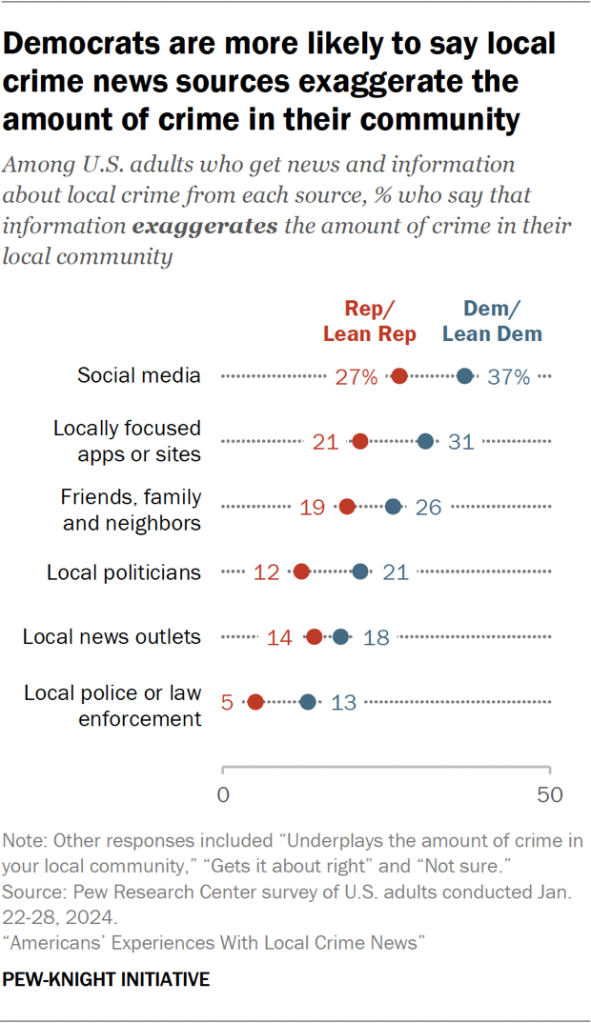
By political party: Virtually identical shares of Republicans and Democrats, including independents who lean toward either party, say the news they get about local crime often makes them feel concerned about what is happening. People in both partisan coalitions also express similar levels of satisfaction with most sources of local crime news.
However, Democrats who get local crime news from each source we asked about are more likely than Republicans to say the information they get exaggerates the amount of crime in their community. And Democrats who get crime information from local law enforcement are about three times as likely as Republicans to say the information is unfair to some people depending on their race and ethnicity (34% vs. 11%).
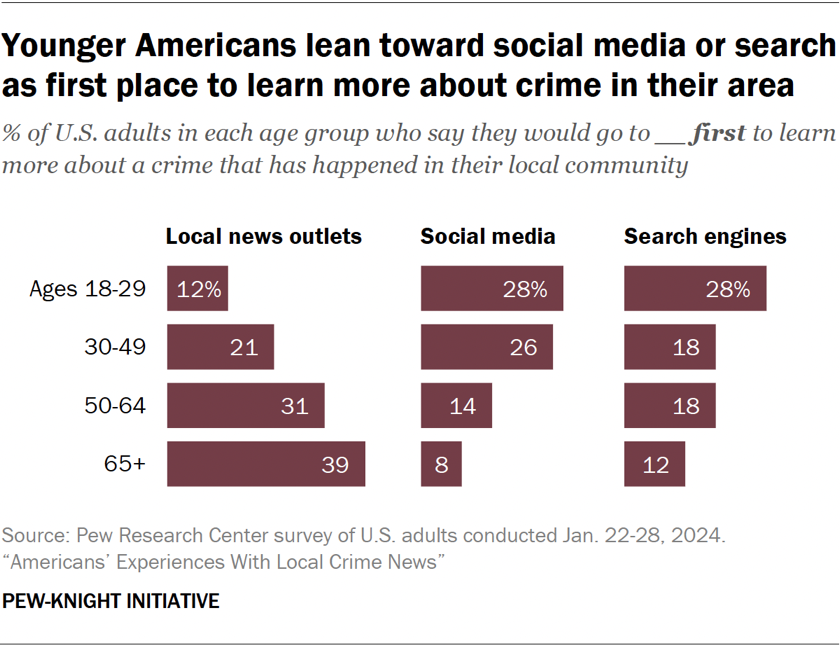
By age: When it comes to which sources people turn to first for information about a crime in their community, most adults ages 18 to 29 say they turn first to social media or search engines (28% each). Those 65 and older most commonly turn to local news outlets (39%).
Younger and older Americans also respond differently to news about local crime. Adults under 30 are more likely than those 50 and older to say they have posted on social media or somewhere else online about crime in their community. Meanwhile, those ages 50 and older are more likely to have expressed concerns about crime in their community to local officials or the police.
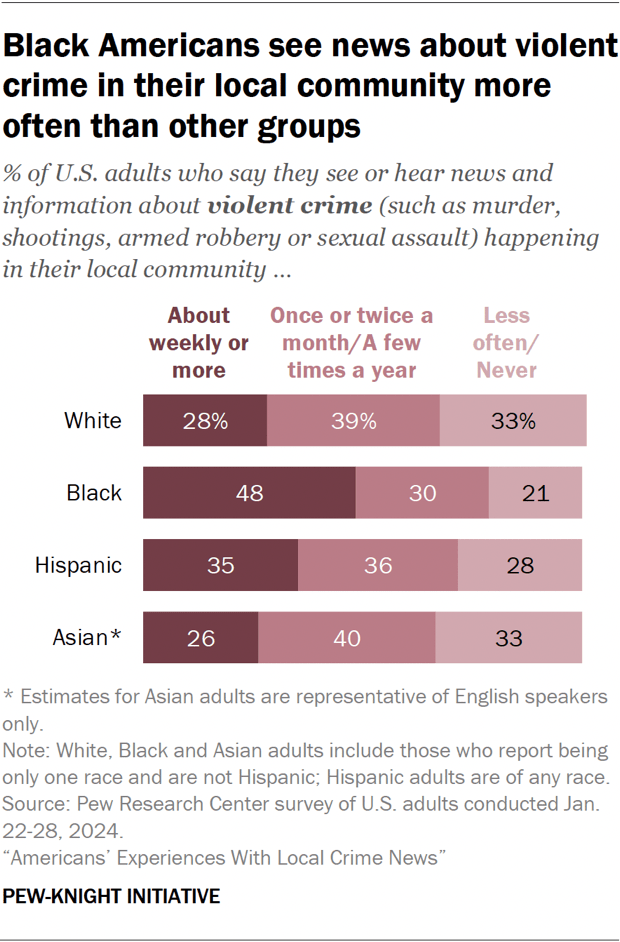
By race: Black Americans have distinctly different experiences with and perceptions of crime news than other racial and ethnic groups. For instance, Black Americans see or hear more local crime news – and specifically news about violent crime – than other racial and ethnic groups.
This aligns with our finding that Black Americans more closely follow local and neighborhood news in general, too. Black Americans are also more likely to express concerns about violent crime, and they are more likely than White and Asian Americans to say reducing crime should be a top issue for the president and Congress to address.
Black Americans are more likely than other groups to see crime information coming from local law enforcement and local news outlets as unfair to some people depending on their race or ethnicity.
Previous Pew Research Center studies have found that Black Americans are more likely to perceive racial bias in policing as well as in news coverage of Black people in general.
